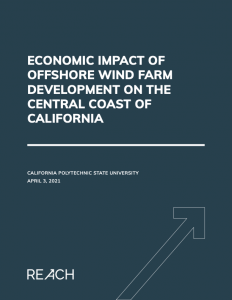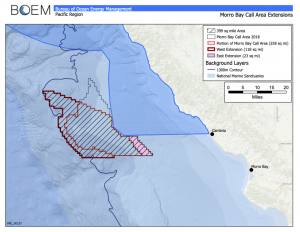Assessing feasibility of a specialized wind port on the Central Coast is urgent next step, state leaders agree
 A 3 gigawatt wind farm off the coast of Morro Bay could generate 650 good-paying jobs and $262 million in annual economic impact on San Luis Obispo and Santa Barbara Counties, a new REACH-commissioned study shows.
A 3 gigawatt wind farm off the coast of Morro Bay could generate 650 good-paying jobs and $262 million in annual economic impact on San Luis Obispo and Santa Barbara Counties, a new REACH-commissioned study shows.
But while the wind turbines would be located off the shores of San Luis Obispo County, the jobs and economic benefits will flow through the port where the turbines are assembled and maintained, the Cal Poly study shows.
“Making economic benefits from OSW (offshore wind) development a reality for San Luis Obispo County will require developing a specialized wind port as a hub for OSW jobs and regional supply-chain development,” it states.
Local and state leaders are pursuing a feasibility study of such a port on the Central Coast as an urgent next step following the joint state and federal announcement to move ahead with offshore wind in a 399-square-mile area off the coast of Morro Bay.
“We need to step up and explore what it would take to make sure those jobs land here in SLO County,” said SLO County Supervisor Dawn Ortiz-Legg. “We have a long history as an energy-producing county, and this offers the possibility of reinventing that legacy as a central underpinning of our economy.”
“The 399 square miles of the Morro Bay offshore wind call area has the distinct advantage of access to adequate bulk transmission that connects to the state electricity grid,” said Walt Musial, offshore wind manager for the National Renewable Energy Laboratory. “In addition to this critical grid infrastructure, a nearby port is also necessary to enable the development of an offshore wind industry on the Central Coast of California.”
 “Proximity matters,” Musial said. “The port handling construction, maintenance and repairs needs to be relatively close to the call area to achieve low energy costs, reduce emissions and maximize the amount of time the turbines are on the water generating electricity.”
“Proximity matters,” Musial said. “The port handling construction, maintenance and repairs needs to be relatively close to the call area to achieve low energy costs, reduce emissions and maximize the amount of time the turbines are on the water generating electricity.”
Musial and the study’s lead author, Cal Poly Professor Stephen Hamilton, spoke at a roundtable of eight state agencies hosted by Assemblyman Jordan Cunningham and Sen. John Laird on May 14 to discuss the study results and ways to enable the industry to take root in the state. One outcome was consensus on the need for a port feasibility study.
Construction of a specialized wind port would bring its own benefits, according to the Cal Poly study, including a $412 million annual economic impact to SLO and Santa Barbara Counties and 2,411 annual jobs over the 5-year project.
Workforce and supply chain development are also among the factors that local, state and federal policymakers must address.
“Unlocking the state’s offshore wind energy potential is a case study in the challenges and opportunities involved in the 21st-century clean energy transition,” Hamilton said. “The economic potential is clear, but making it a reality will take considerable coordination between government and industry at the local, state and national level.”
Quantifying the winds of opportunity
The study looked at the job-creation, economic and fiscal impacts of offshore wind development in the two original federally designated “call areas” about 30 miles off the shores of San Luis Obispo County and an expanded Morro Bay call area scenario. The study examined the impacts of a variety of development scenarios, from 1 GW up to the full 7 GW the call areas could support.
“The payoff to the San Luis Obispo County region for developing a regional supply chain for OSW power is the creation of a green energy sector that can provide head-of-household jobs, health and retirement benefits, and career opportunities for workers in the green economy, including the potential to deliver jobs to workers from disadvantaged communities,” the report states.
At 7 GW, offshore wind farms could generate up to 1,469 good-paying jobs and $707 million in annual economic impact across the two counties, the report found.
REACH commissioned the study to establish what offshore wind — well established in Europe but a relatively new industry in the United States — would mean for the region’s economy.
“The analysis made abundantly clear that the economic benefits associated with offshore wind take place at a specialized wind port. Without a specialized wind port on the Central Coast, the economic potential will not be realized here,” REACH CEO Melissa James said. “We have many of the ingredients necessary for offshore wind to take off here: 399 square miles to develop offshore wind farms, transmission infrastructure at Morro Bay and Diablo, and a workforce impacted by the change in the state’s energy goals, ready and willing to be put to work. Now we just need to diligently look at the suitability of the infrastructure necessary to support the industry long into the future.”
The benefits outlined in the study would go a long way toward mitigating the impacts of Diablo Canyon Power Plant’s imminent closure, including up to $35 million annually in taxes to SLO County and hundreds of jobs paying an average of $89,000 annually.
“With the closure of Diablo Canyon, the Oceano Dunes, Phillips 66 and now potentially the California Men’s Colony, let alone COVID-19, our economy is taking some big hits,” said Ortiz-Legg, whose 3rd District encompasses Diablo Canyon. “We have a lot of valuable assets — chief among them existing transmission lines at Diablo and Morro Bay — that we can leverage to create jobs and economic opportunity into the future. That’s why offshore wind has been a key area of focus for the group of partners working on Diablo’s future.”
Investments in Infrastructure
On the national level, the federal government is making unprecedented new investments in jumpstarting the industry, from the recent announcement of a major East Coast project to offering $3 billion in federal loan guarantees for offshore wind projects and $230 million for port upgrades.
The state has followed suit with the announcement of $20M to support offshore wind infrastructure design, planning and environmental review.
The investments are key to reaching the federal government’s goal of 100% clean energy by 2050 and 30 GW of offshore wind energy by 2030. The State of California has committed to be carbon free by 2045, which will require 6 GW of additional renewable energy to be added every year, according to a 2021 joint state agency study.
“If the state is going to meet its ambitious clean energy goals, it needs to diversify its power generation portfolio. Offshore wind is a win-win-win for the state and the Central Coast: more jobs, more clean power, and more tax revenue for local government,” said Cunningham, the co-author of a bill that would formalize the state’s commitment to offshore wind power.
“What is absolutely clear is that to mitigate the devastating effects of climate change, we must move away from burning fossil fuels,” Laird said. “During my tenure as Secretary for the California Natural Resources Agency, it became increasingly clear one of the most promising technologies in this regard is offshore wind. It has the potential to deliver large amounts of clean, renewable energy to communities across the state. There is a critical opportunity for OSW technology along the Central Coast within the 17th Senate District that I represent. In my district, the closure of the Diablo Canyon Power Plant by 2025 presents us with unique opportunities to connect to California’s electricity grid and secure local jobs. For these reasons, I am a co-author of Assembly Bill 525 to promote wind technologies for the benefit of the Central Coast and all Californians.”
In Morro Bay, the city is also considering a project to transform an old power plant into the world’s largest battery storage, taking advantage of existing transmission lines there.
“Morro Bay is excited to be part of the 21st-century energy transition,” Morro Bay Mayor John Headding said. “We look forward to continuing conversations with industry, state and federal partners and our community about how to put this infrastructure to work for our economy and for a sustainable future.”